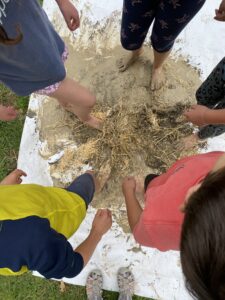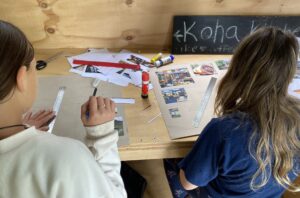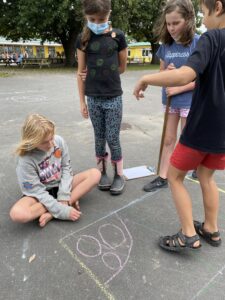
Papatūānuku - Earth Mother
Collaborative partnership delivers rich eco-building learning for students.
It was an irresistible invitation to the students of South End School: “Do you want to search out clues? Unlock secrets? Get dirty?” Of course they did!

Eco-building workshop flyer
Stepping gently on Papatūānuku: An Ecobuilding Workshop for light-footed rangatahi was a collaboration between Enviroschools Wairarapa and Te Kura o Papatūānuku Wairarapa Earth School Charitable Trust. The intention was to shift students’ thinking – from seeing building as a purely functional process to also treating it as an ecological process.
The facilitators used concepts from the newly-released Enviroschools Ecological Building Theme Area resource .Twenty four students (Years 5 – 8) had a chance to get hands-on, both literally and figuratively, resulting in some deep learning.

Building with Cobb
“We made little buildings using the straw cobb,” says Billy Reiri, a Year 6 student who enjoyed ‘the dance party’ when the students mixed the straw, sand, water and clay together with their feet. “The cobb was like mud and the walls kept falling down. We had to use different techniques like squashing it around willow branches to keep it up. To make the roof stay up, we had to use another technique.”
Getting physically involved in creating their own building materials enables ākonga to experience one of the four main concepts of the theme area resource: buildings come from nature and return to nature – Enviroschools Ecological Building Theme Area
The day was structured around the processes of investigating, designing and building, culminating in a whole-group building activity in the afternoon using clay straw cobb. This provided a wonderful way to bring together all the noticing, exploring, thinking, problem solving and designing which happened across the day.
Investigating

An eco-building scavenger hunt helped students to look closer at their buildings and to think about their purposes and impact.
The morning began with a scavenger hunt. As the students raced around exploring the food forest space, they were also seamlessly laying the foundation for their day’s work by exploring the ecological building principles.
They looked at how the elements and ngā atua shaped and impacted the space. “We noticed where the ants and spiders were living, and where the birds liked to come to,” says Fuschia Rapson. They looked at the materials that had been used to build and how things had been reused. And they thought about how the different areas influenced how people felt and how they might move through those areas.
“These kids are very aware of nature and their natural surroundings,” says Garden Teacher, Rohan Cahill-Fleury, “and they’re really familiar with that space.
“But they’d never thought about it in a building context before. They began to talk about what had been put where and why, the purpose of the buildings and materials, and where the water goes when it rains.” – teacher, Rohan Cahill-Fleury
Designing for authentic purposes
The three design challenges which made up the middle part of the day were built around real-life projects connected to the Earth School’s community.
Te Kura o Papatūānuku is made up of two part-time teachers and a group of regular expert mentor volunteers, who run sessions, projects, workshops, events and an outdoor learning space on the grounds of South End School in Carterton. Most of the students who take part in the regular projects in and around the food forest and outdoor classroom are from South End School. The purpose-designed teaching gardens also host ākonga from other schools and the team regularly run workshops at schools across the region.
Outdoor kitchen design

Planning where the water goes
One group worked with the existing natural elements to design an outdoor kitchen which incorporated a pizza oven and which was durable and usable in all weathers.
The basic design for the kitchen had already been done but the ākonga were asked to explore potential sites and consider aspects such as sun, shelter, wind and water. Students captured their ideas as drawings on graph paper so they were able to link their designs with each of the other aspects being planned. Being on-site to do the designing was invaluable – one group began by planning how to capture roof water for the kitchen sink and ended up incorporating a water supply for the nearby chicken coop.
This ties in of the theme area concepts: “Ecological building taps into the abundance of energy and renewable resources in our natural world, creating life giving environments.”
“Ecological building works with nature and enhances the health and wellbeing of the whole community.” Key Concept, Enviroschools Ecological Building Theme Area
Lab extension design
Mapping also played a key role in the design of an outdoor extension to the shipping container which had recently been converted into a science lab. A gorgeous array of maps and plans were produced, capturing aspects of design such as how people might move in and out of the building.

“Ecological building is an integrating activity that embraces art, science, communication and practical skill.”
In order to move the project from a purely functional design to an ecological one, teacher Emilie Fleur Neubauer asked the students;
“How can we use nature’s elements to enhance what we do? How can people use the space in all weathers? How do we want people to use the space – come in and out? What living landscapes are already here?” – asked teacher, Emilie Fleur Neubauer
The design journey that was launched by these questions culminated in ideas such as creating a low wall around the area outside, using a cobb mix with bottles in it, to create a surface for people to work on.
Designing for small spaces
Rohan Cahill-Fleury, had recently built a tiny house, and led a third design workshop exploring the implications of designing something small and specific. There was animated discussion around wants and needs and how “needs” has to be the focus when designing a tiny home.
The group also had the expertise of Toby Rosenberg , a structural engineer, a draughtsman and expert mentor volunteer at Te Kura o Papa, who was on hand to provide advice, ask questions and give support around the scale drawing.
Drawing their tiny house plans at actual size on the tennis court “really bought their plans to life and brought up a whole new lot of questions,” says teacher Rohan


Chalking the designs onto the concrete court design brought up issues such as ‘‘where will the water fall from our shower if we put the nozzle here?’, and ‘did we leave enough room to put our legs when we are sitting on the toilet?!’”
“It made me look at the rooms at our house a bit differently,” says year 6 student Aroha Castro Recio. “In a tiny house you have a really tiny bathroom. We might not need all the space, but you do need somewhere to stand when you get out of the shower!”
Building Rich Partnerships
“Co-designing the workshop with Earth School meant that we could explore the ecological building concepts in a real-life context,” says Wairarapa Enviroschools facilitator Gill Stewart. “Earth School has the experts and we have the network and organising capacity, so the collaboration works well.”
The workshop was held with students from only one school due to Covid-19, but Gill is looking forward to bringing it to other schools in the Wairarapa later in the year. “It will be great to bring kids together and allow for cross-pollination of ideas.”
“Working with different adults meant introducing the kids to lots of different aspects of designing and building,” says Rohan “They came away with lots of plans for using their environment – and a different way of looking at it.”
![]()
The Enviroschools Theme Areas have been developed as part of the suite of Enviroschools resources that support young people, their whānau and communities to move towards a healthy, peaceful and sustainable world.
Each Theme Area is an enquiry-based learning resource for schools and centres on their Enviroschools journey containing focus questions, activities and background text as well as supporting case studies, to guide exploration and assessment of the environment.
Registered Enviroschools can access hard copies of the Theme Area resources through their Enviroschools facilitator and digital copies from the Team Area of the website.
